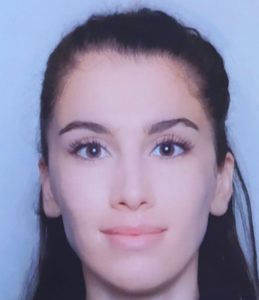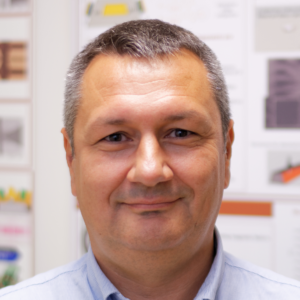Overview
The Magnetic Random Access Memories (MRAM) group develops advanced concepts in this emerging technology. The goal is to realize cells with improved thermal stability, lower power consumption and/or faster switching. Our research covers material stack deposition, nano-fabrication and electrical test evaluation, for applications as standalone memory and non-volatile logic and more recently in neuromorphic computing architectures.
Research directions
Perpendicular Anisotropy Materials
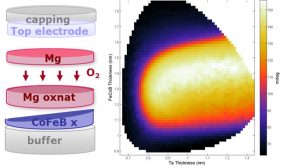
High energy barriers for spin transfer torque (STT) MRAM cells can be achieved with perpendicular anisotropy magnetic tunnel junctions. Solutions for high density MRAM cells to diameters below 20nm require continuous improvements in perpendicular surface anisotropy, while maintaining high TMR properties.
Perpendicular STT MRAM
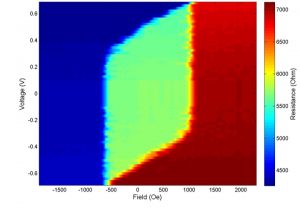
Evaluation of MRAM concepts requires simulation of expected reversal mechanisms and electrical characterization of individual cells. We aim at understanding dynamics of magnetization reversal and the expected impact of stack modifications to explore application specific optimizations.
Nanofabrication Challenges
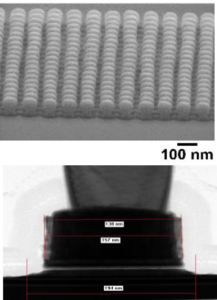
Innovation on dense MRAM using pre-patterned substrates, CMOS integration of multifunctional cells and sub-10nm lateral sizes. Tunnel junction nanofabrication in our platform is essential to evaluate MRAM concepts and performance.
Perpendicular Shape Anisotropy
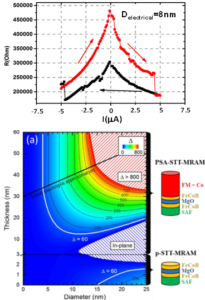
A solution for sub-10nm cell sizes uses high aspect ratios to generate perpendicular shape anisotropy providing scalable retention at the smallest cell sizes. Spin transfer torque switching is possible in these cells, where the reversal dynamics is now under study.
The team
Former members
Post-docs
- Andrey TIMOPHEEV (2014-2017)
- Van Dai NGUYEN (2016-2018)
- J. Ranier Roiz (2015-2016)
- Nikita Strelkov (2016-2019)
PhD
- Luc TILLIE (2015-2018)
- Nicolas PERRISSIN (2015-2018)
- Jyotirmoy CHATTERGEE (2014-2017)
- Hieu Tan NGUYEN (2013-2016)
- Antoine Chavent (2013-2015)
Process Engineers
- Jude GUELFFUCCI (2015-2017)
- Nathalie LAMARD (2016-2017)
- Guillaume LAVAITTE (2015-2016)
Projects
- Samsung SGMI (2014-2017)
- ANR Excalyb (2014-2017)
- Heumem (2015-2018)
- EU-FET Spice (2016-2019)
- EU Great (2016-2019)
- ERC Magical (2015-2020)
Partners
- CEA LETI, Grenoble, France
- Institut NEEL, Grenoble, France
- Crocus Technology, Grenoble, France
- Samsung, San Jose, USA
- Singulus AG, Kahl am Main, Germany
- Aarhus University, Aarhus, Denmark
- Radboud Universiteit, Neijmegen, Netherlands
Recent news
- seminar – Measuring MRAM with Scanning NV Microscopy (March 03rd, 2023)

On Tuesday, March 07th 2023, we have the pleasure to welcome in SPINTEC Mathieu MUNSCH CEO and Co-founder of QNAMI. He will give us a seminar at 16:00, entitled: Measuring MRAM with Scanning NV Microscopy Place: SPINTEC ... - Seminar – Coupled magnetic and molecular dynamics: Methodology and application to the simulation of magneto-elastic effects in iron (March 01st, 2023)

On Thursday, March 16 2023, we have the pleasure to welcome in SPINTEC Julien Tranchida, Research Scientist at CEA Cadarache. He will give us a seminar at 14:00, entitled: Coupled magnetic and molecular dynamics: Methodology and ... - Waking-up wireless sensor nodes with perpendicular magnetic tunnel junctions (December 19th, 2022)

Spin-torque-nanodiodes based on magnetic tunnel junctions are promising candidates for RF energy harvesters and ultra-low power wake-up receivers with performances that are expected to surpass those of semiconductor diodes. Experiments on magnetic tunnel junctions with ... - Seminar – Characterization of the Switching Distributions of Heat-Assisted Magnetic-Recording Media (November 14th, 2022)

On Tuesday, November 22th, Pierre-Olivier Jubert Senior Technologist at Western Digital, San Jose (USA) will give us seminar on-line at 16:00, entitled : Characterization of the Switching Distributions of Heat-Assisted Magnetic-Recording Media Place : CEA Building 10.05 ... - Masters thesis projects for Spring 2023 (September 21st, 2022)

You find here the list of proposals for Master-2 internships to take place at Spintec during Spring 2023. In most cases, these internships are intended to be suitable for a longer-term PhD work. Interested Master-1 ...






